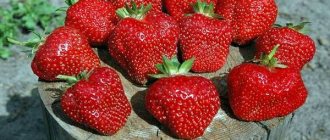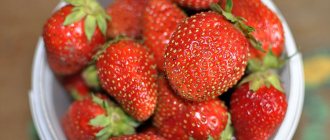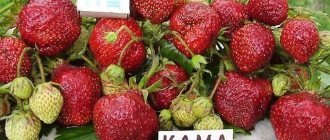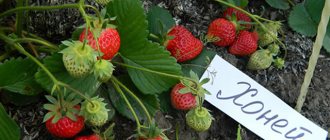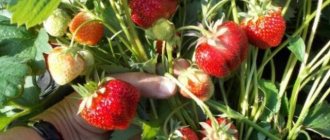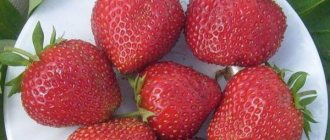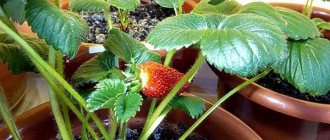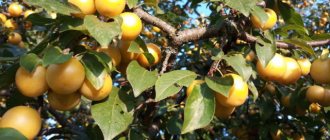Festival chamomile is a non-repairing variety of garden strawberry. The variety was developed in Ukraine in the late 1980s. The following strawberry varieties took part in the breeding work:
- Redcoat.
- Dawn.
In 1992, the variety was included in the State Register of Ukraine; the variety is not listed in the State Register of the Russian Federation.
In Russia, Festival chamomile is recommended to be grown in the following regions of the country:
- Central.
- East Siberian.
- West Siberian.
- Uralsk.
In this article you will learn a description of the variety, read reviews from gardeners about the Ukrainian beauty, and also see photos of its berries.
Characteristics of the variety
Strawberry Festival Chamomile is a medium variety. Despite the fact that the variety was bred quite a long time ago, it is still very popular among gardeners.
Here are the main characteristics of the Ukrainian variety of garden strawberries:
- The plant is compact, semi-spreading. The bush is quite tall in height. The leaves are medium sized, pale green in color. There are wrinkles on the surface of the leaf plates, but they are not very pronounced.
- Educational ability is at its best. The bushes form a fairly large number of tendrils of a reddish-green hue. Due to the abundant number of whiskers, caring for the crop becomes somewhat more complicated. Although, for those who grow strawberries to sell seedlings, a large number of mustaches will only be a plus.
- The bush forms a fairly large number of flower stalks. The flowers are bisexual and self-pollinating, so there is no need to plant an additional pollinator. The flower stalks are quite powerful and hold even ripe berries well. They are located at the level of the leaves or slightly below.
- In the southern regions of our country, you can start harvesting from the 2nd half of June. Those who grow this variety in the northern regions of our country can taste the first harvest at the beginning of July. The fruiting of Ukrainian strawberries itself lasts until the onset of frost.
- The berry is quite large, about 45 grams. This is at the 1st harvest. As with many varieties of garden strawberries, this is characterized by a significant reduction in berry size by the end of the growing season.
- The berries are not ideally shaped, slightly flattened on the sides.
- The fruits are bright red. The surface of the berry is glossy. The pulp of the fruit is the same color as its shell. The fruits are juicy, sweet and sour. The structure of strawberries is dense, which is a huge advantage for strawberry producers, since they can be harvested mechanically and transported over long distances (they do not squash or leak).
- The purpose is universal. It can be frozen, dried, processed (prepared jam, jam, compote).
- Strawberries of this variety are characterized by high yields. From 1 bush of Festival chamomile, up to 500 g of marketable products are collected.
- Strawberries are drought-resistant and frost-resistant varieties. It can be grown even in the northern regions of our country.
- Thanks to its strong immunity, the plant is resistant to a number of diseases.
Features of care
Based on the description of the variety and its characteristics, growing Festival Chamomile strawberries is not difficult.
Main:
- Choose a sunny place, fertile, breathable soil. It is better to plant seedlings in beds where carrots, garlic, onions, zucchini and pumpkin previously grew. Planting in the shade and after potatoes and tomatoes is not recommended due to poor lighting and the possibility of fungal diseases.
- When planting, take into account the distance between the bushes of at least 25 cm. When planting in two rows, the row spacing should be about 60 cm. First-year strawberries do not bear fruit, but throw out tendrils, which must be directed into the row spacing. The planting diagram is in the photo below.
All other agrotechnical methods for caring for Festival Chamomile strawberries are no different: watering, loosening, weeding, timely fertilizing, pest and disease control.
A gardener's opinion about the Festival Chamomile and the secrets of growing it:
Positive and negative qualities of strawberry Festival chamomile
The variety has simply a huge number of advantages, thanks to which it is still very popular among gardeners. The main advantages of Festival Chamomile include:
- The variety has excellent frost resistance.
- Strawberries are quite easy to care for.
- The fruits ripen very early.
- The variety is quite high-yielding. From 1 bush, under good care conditions, you can collect up to 500 grams of berries.
- Due to the fact that the bush forms a large number of tendrils, the variety is very easy to propagate.
- The fruits are very tasty, sweet, aromatic.
- The berries are dense, which allows them to be collected mechanically. Also, the berries are not afraid of transportation. They don't flow or wrinkle.
- The variety has a fairly strong immunity that protects the crop from various fungal diseases.
At the same time, we should not forget that, like any other garden strawberry, Festival chamomile has its drawbacks. The main disadvantages of this variety include:
- Despite the fairly strong immunity, the variety is still susceptible to diseases such as powdery mildew.
- As for parasites, Festival chamomile is often affected by the strawberry mite.
Origin and growing regions
The variety was bred by specialists from the Institute of Horticulture of the National Academy of Agrarian Sciences of Ukraine under the guidance of outstanding scientist-breeders V.P. and K.N. Kopan by crossing the Zarya and Redcoat varietal lines. In 1992, it was officially registered in the State Register of Plants approved for cultivation on the territory of Ukraine, recommended for cultivation in natural areas of Polesie, forest-steppe and steppe.
The Kopan spouses - Vladimir Pavlovich (Doctor of Agricultural Sciences) and Kira Nikolaevna (PhD of Agricultural Sciences) - are known as the authors of more than 170 varieties of fruit and berry crops, 56 of which are included in the State Register of Ukraine.
The results of variety trials conducted in various regions of Russia confirmed the ability of “Festival Chamomile” to be highly adaptable and productive in the climatic conditions of the middle zone, western and eastern Siberia. And although the variety is not listed in the State Register of the Russian Federation, state enterprises are engaged in its breeding and distribution, for example, the Federal State Unitary Enterprise Novosibirsk ZSS Rosselkhozakademii (Berdsk) and NIISS named after. M. A. Lisavenko (Barnaul), as well as many well-known agricultural companies and nurseries.
The bushes are medium-sized (about 20 cm in height), densely leafy, semi-spreading. The leaves are quite large, dark green in color (with a bluish bloom), matte, medium-wrinkled, concave. The whiskers are green (with a reddish tint), of medium thickness, and are formed in moderate quantities. From 10 to 15 thick and powerful peduncles are formed on the bush, located at the level of the leaves or slightly lower, lying slightly to the ground under the weight of the filling fruits. Compact inflorescences consist of numerous (more than 50 per bush) white, bisexual flowers.
Ripening dates and consumer qualities of berries
The variety is classified as mid-early or mid-ripening with a short ripening period. The beginning of fruiting occurs mainly in the second decade of June. The harvest ripens very quickly, almost simultaneously within 10-15 days. The berries of the first harvest are larger in size and weigh up to 35-40 g, the subsequent ones are much smaller - from 6 to 20 g.
The berries have a regular round or blunt conical shape, with a neck, and are symmetrical. When ripe, the skin acquires a rich dark or orange-red color and a pronounced shine. The pulp is bright red, juicy, quite dense, has a pleasant and balanced sweet and sour taste, and a characteristic strawberry aroma.
Tasting scores for fresh berries are excellent: 4.6-4.9 points (out of 5). Product and consumer qualities are estimated at 7.8-8.3 points (out of 9).
The berries of this variety contain:
The fruits are universal in culinary use: perfect for fresh consumption, preparation of various desserts, whole fruit jam and other methods of processing, freezing. They do not get injured or wrinkle during transportation, and retain their shape and texture uniformity during heat treatment.
Productivity
In different weather and climatic conditions and depending on the intensity of agricultural technology, productivity indicators range from medium to high. According to the originator, yields can be up to 170-190 c/ha. The variety is considered suitable for mechanized harvesting, since the berries, located on powerful peduncles, practically do not lie on the ground. They are more evenly illuminated by the sun and ventilated, remain dry and clean, are clearly visible on the bushes and are quite large in size, so they are easy to assemble. Gardeners receive an average of 400-650 g of berries per bush.
Sustainability and agrotechnical features
“Festival chamomile” tolerates winter frosts well (down to −25 ℃) and in most regions overwinters without special shelter, under snow cover. Compared to other varieties, it exhibits higher resistance to drought.
Due to the compact size of the plants, they are placed at a distance of 20-25 cm from each other, using a single-line or double-line planting pattern, with row spacing made 60-70 cm wide. Seedlings are planted in early spring after the frosts have stopped or from late August to mid-September. It is better to choose areas for strawberries that are flat, open, sunny, with fertile soil. The variety is resistant to powdery mildew, and is moderately susceptible to white and brown leaf spots, gray fruit rot and strawberry mite damage. However, too wet, shaded places, where the risk of plant damage by fungal diseases is much higher, are not suitable for planting. Also, we should not forget about preventive treatments.
For care, standard agrotechnical techniques are used: regular (not excessive) watering, fertilizing with organic or mineral fertilizers 2-3 times per season, mulching or weeding and loosening the soil. To obtain maximum yields, all tendrils must be removed. It makes sense to leave shoots only on young and healthy plants intended for breeding that have pronounced varietal characteristics. To make the seedlings stronger and take root faster, the flower stalks on the mother bushes are cut off. It is recommended to rejuvenate plantings after 3-4 years of active fruiting of plants in one place.
Gleb, 43 years old, Samara
For a long time I thought that Festival strawberries and Festival Chamomile were the same variety. But after reading on the Internet, I realized that the varieties are different, although similar in many respects. I decided to try both. They ripen almost simultaneously, but in Chamomile the fruiting is more intense and shorter. The berries are smaller, but smoother and more uniform in appearance, and I liked them better in taste: not too sweet, with a pleasant, refreshing sourness. In our conditions, these varieties suffer greatly from droughts. If you don’t water at least every other day, flower stalks set poorly and productivity drops by almost half. With constant care, the yield is very decent - on average 500 grams per bush.
Evgeniya, 48 years old, Bryansk region.
We have been growing Festival chamomile strawberries for more than 10 years. We initially bought seedlings from a good nursery, but now we use our own and select the strongest and healthiest ones. After autumn planting, young bushes bear fruit abundantly the following season. Good harvests are also obtained in the next 2-3 years. The berries are not huge and not cloying, the taste is balanced and pleasant, but for some it is sour. Dense and aromatic, they perfectly complement the sweetness in any confectionery desserts; they make fantastic jam. The peduncles are very strong, support the weight of the berries well, and they ripen quite high, so they remain dry and clean, rarely damaged by gray rot, but they need to be treated for strawberry mites.
Read also: Derain White Aurea: description, planting and care, photo
Rimma, 50 years old, Kharkov
I love festival chamomile strawberries for their ease of care, which even a novice gardener can handle, and for their delicious, aromatic berry. Every summer I look forward to seeing it begin to ripen quickly and amicably. The yield of the variety is stable and high. You can eat plenty of fresh strawberries and do all the winter preparations at once. In my experience, the main thing for her is the appropriate level of soil moisture, so we installed a drip irrigation system on the site and mulched the beds with straw. It winters well and copes well with sudden temperature changes, frosts and heat.
A gardener from Kemerovo talks about his experience in growing strawberries of the “Festival Chamomile” variety in the following video:
For several years she worked as a television program editor with leading producers of ornamental plants in Ukraine. At the dacha, of all types of agricultural work, she prefers harvesting, but for this she is ready to regularly weed, pull, shed, water, tie, thin out, etc. I am convinced that the most delicious vegetables and fruits are those grown with your own hands!
Found a mistake? Select the text with the mouse and click:
“Frost-resistant” varieties of garden strawberries (more often simply “strawberries”) need shelter just as much as ordinary varieties (especially in those regions where there are snowless winters or frosts alternating with thaws). All strawberries have superficial roots. This means that without shelter they freeze to death. Sellers’ assurances that strawberries are “frost-resistant,” “winter-hardy,” “tolerates frosts down to −35 ℃,” etc. are deception. Gardeners must remember that no one has yet managed to change the root system of strawberries.
Compost is rotted organic remains of various origins. How to do it? They put everything in a heap, hole or large box: kitchen scraps, tops of garden crops, weeds cut before flowering, thin twigs. All this is layered with phosphate rock, sometimes straw, earth or peat. (Some summer residents add special composting accelerators.) Cover with film. During the process of overheating, the pile is periodically turned or pierced to bring in fresh air. Typically, compost “ripens” for 2 years, but with modern additives it can be ready in one summer season.
Convenient Android applications have been developed to help gardeners and gardeners. First of all, these are sowing (lunar, flower, etc.) calendars, thematic magazines, and collections of useful tips. With their help, you can choose a day favorable for planting each type of plant, determine the timing of their ripening and harvest on time.
Oklahoma farmer Carl Burns developed an unusual variety of multi-colored corn called Rainbow Corn. The grains on each cob are of different colors and shades: brown, pink, purple, blue, green, etc. This result was achieved through many years of selecting the most colored ordinary varieties and crossing them.
Tomatoes have no natural protection against late blight. If late blight attacks, any tomatoes (and potatoes too) die, no matter what is said in the description of the varieties (“variety resistant to late blight” is just a marketing ploy).
The homeland of pepper is America, but the main breeding work on developing sweet varieties was carried out, in particular, by Ferenc Horvath (Hungary) in the 20s. XX century in Europe, mainly in the Balkans. Pepper came to Russia from Bulgaria, which is why it received its usual name - “Bulgarian”.
Natural toxins are found in many plants; Those grown in gardens and vegetable gardens are no exception. Thus, the seeds of apples, apricots, and peaches contain hydrocyanic acid, and the tops and peels of unripe nightshades (potatoes, eggplants, tomatoes) contain solanine. But do not be afraid: their number is too small.
Humus is rotted manure or bird droppings. It is prepared like this: the manure is piled up in a heap or pile, layered with sawdust, peat and garden soil. The pile is covered with film to stabilize temperature and humidity (this is necessary to increase the activity of microorganisms). The fertilizer “ripens” within 2-5 years, depending on external conditions and the composition of the feedstock. The output is a loose, homogeneous mass with a pleasant smell of fresh earth.
You need to collect medicinal flowers and inflorescences at the very beginning of the flowering period, when the content of nutrients in them is highest. Flowers are supposed to be picked by hand, tearing off the rough stalks. Dry the collected flowers and herbs, scattered in a thin layer, in a cool room at natural temperature without access to direct sunlight.
How to grow and care for garden strawberries
Care is the most important procedure on which the future harvest of a crop depends. However, do not forget about the correct planting of strawberries. Festival chamomile is planted in the following ways:
- One-liner. With this method, the distance between the bushes is kept at 15-25 cm, and the distance between the rows is about 60-80 cm.
- Two-line. With this method, the distance between plants is increased to 20-40 cm, and the rows are made double-line. That is, two rows with a distance of 20-40 cm, then a row with a distance of 60-80 cm, then again 2 rows with a distance of 20-40 cm.
Garden strawberries are planted in spring or autumn (late summer). It is advisable to plant in late summer (August), since under such conditions it will be possible to get a harvest next year.
Strawberries are planted according to the following scheme:
- Prepare the wells. They are pulled out depending on the depth of the root system.
- After the holes are ready, they are watered generously with water, approximately 1 liter per hole.
- When the water is absorbed, you can place the seedling in the hole. It must be placed strictly vertically.
- When the seedling is in the hole, it is sprinkled with soil and compacted.
- At the end of the work, each bush is watered with water, approximately 1 liter per plant.
After planting, it is necessary to care for the strawberries. First of all, it needs to be watered regularly. Water strawberries in the evening or early morning, when the sun is in an inactive phase and will not burn the leaves of the crop. As a standard, strawberries are watered once a week. During hot weather, the number of waterings is increased to 2-3 per week.
We also recommend reading: Description of the Syrian strawberry variety
The second no less important agrotechnical procedure is the fertilization of strawberries. Fertilize it 3 times per season:
- The first time is in early spring, in order to awaken the plant from sleep. Nitrogen-containing fertilizers are ideal as spring feeding.
- The second time strawberries are fertilized after the ovaries have formed. In this case, phosphorus-potassium fertilizers are used.
- The last time strawberries are fertilized with organic matter is to prepare them for wintering.
Reproduction
Strawberries, the Festival Chamomile variety, can be propagated in several ways:
- seeds;
- dividing the bush;
- rooting the mustache.
Everyone chooses for themselves exactly how to plant a crop. Let's consider all the options.
Seeds
Seed propagation is a rather lengthy and painstaking task. To obtain high-quality seedlings, seeds must be purchased from trusted suppliers.
Seeds are sown in early February using a surface method. For rapid germination, the seed is covered with polyethylene or glass to create a microgreenhouse. Picking is carried out at the stage of 3 true leaves.
Important! Strawberries grown from seeds begin to produce fruit only in the second year.
Rooting a mustache
Festival chamomile, produces copious amounts of whiskers. To obtain a rich harvest, the mustache must be removed during flowering and fruiting, as it greatly depletes the uterine bush. If it is necessary to grow additional planting material, all flower stalks are cut off from the bush and no more than five of the strongest rosettes are left. Root only the first rosette, directly on the garden bed or in a cup.
Note! The preparation of planting material can be done at any time. If strawberry bushes are needed for next year, the mustaches are rooted at the end of summer.
When growing garden strawberries in regions with a harsh climate, the rooted tendrils are removed for the winter in a cool place until future planting. In other regions, rooted bushes are transplanted to a permanent place and covered with prepared mulch for the winter.
Dividing the bush
The most popular and convenient method of reproduction.
To obtain a harvest in the year of planting, dividing the bush must be done in early spring.
Pests and diseases
As noted earlier, the variety has fairly strong immunity. However, if the crop is not properly cared for, it can still encounter a number of problems. The main problems that the Festival chamomile may encounter include:
- Spider mite. This parasite infects the leaves, sucking the juice from them. As a result of the pest's activity, the leaf blade becomes yellow and covered with a thin cobweb. The fruits ripen small and deformed. If the plantings are severely affected by this pest, then only pesticides will help. For minor lesions, they resort to folk remedies: garlic infusion, onion peel infusion, etc.
- Nematode. This is a small pest that affects the entire plant. If a pest has infected a bush, it must be quickly removed from the area so that the parasite does not infest healthy bushes.
- Powdery mildew. The main problem facing the Festival Daisy. With this disease, you can observe the appearance of a white coating on the leaf blades. To prevent this disease, you can treat the bushes with soda solution in early spring.
- Verticillium wilt. With this disease, dark spots can be seen on the surface of the leaf. If no measures are taken, the leaves will soon begin to die, the bush will become weak, lethargic and eventually die too. To prevent the plant from infecting healthy bushes, it must be removed from the site and burned.
Reviews from gardeners
Natalya Vladimirovna, Moscow, 54 years old.
An excellent variety. This year I took good care of the strawberries, watered them, fertilized them, and sprayed them against parasites. From my 4 orphans I collected almost a bucket of strawberries. I'm shocked. Festival chamomile is absolutely gorgeous.
Vladimir Igorevich, Kyiv, 42 years old.
I really liked the variety. The berries are tasty and juicy. We grow purely for ourselves. The wife and children are happy. During the entire time of growing this variety, which is approximately 10-12 years, the variety has never encountered serious diseases. For now, the main strawberries are not going to change.


